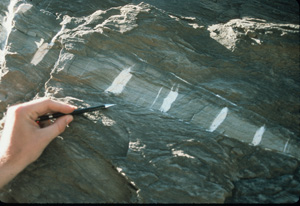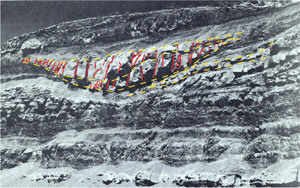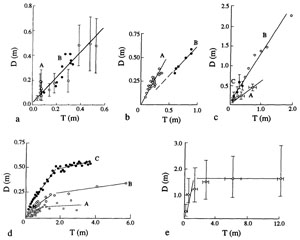| |||||||
|
|
|||||||
|
|
|||||||
| Joint Spacing - Layer Thickness Scaling | |||||||
|
It is a common knowledge that the spacing of joints is somewhat proportional to the thickness of the layers in which they occur. Field examples for supporting this notion are abundant: Figure 1 shows a vein set in a limestone unit which thickens from right to left. Similarly the spacing of the veins appears to increase from the thinner part of the unit on the right side of the image to the thicker part on the left side.
Figure 2 contains a well-developed systematic joint set which, unfortunately, is somewhat oblique to the surface of the cut. Nevertheless, the joint separations on the surface of the exposure decrease toward the perimeters of the sandstone lenses defined by the depositional channel geometry. Finally, Figure 3 shows scanline data from two systematic joint sets in seven sandstone beds with various thicknesses exposed on a road cut (a). Figures 3b, 3c, and 3d show the fracture spacing ratio (FSR- the ratio of median spacing over the layer thickness), the fracture spacing/layer thickness ratio (S/T), and the ratio of the standard deviation of joint sets data and their mean values (CV). In general the data sets indicate a positive correlation between the spacing and the thickness of the mechanical layers in which they occur. The obvious reason for choosing the field cases presented above is that the material properties, the loading, and the total strain for each particular case do not change much if any so that these factors can be taken as constant for each case. However, several other factors influence joint spacing in layered rocks as will be discussed somewhere else in this Knowledgebase. Let's now consider joint spacing-layer thickness relationship data from the literature. Figure 4 is a summary of joint spacing/layer thickness data from the literature (Wu and Pollard, 1995) with individual credit given in the figure caption. Basically, there are two trends in spacing - layer thickness relationships: linear (Figures 4a-c) for thin beds and initially linear followed by nearly constant (Figures 4d, e) for thick beds. For layer thickness exceeding a certain value, a simple linear spacing-thickness relationship does not hold and a constant spacing is maintained beyond this critical value. This critical value is approximately 1.5 meters (Figures 4d-e). According to Price and Cosgrove (1990), beyond this value, spacing is independent of the thickness of layers; on the other hand, in thin layers, spacing is strongly influenced by tractions across the competent/incompetent rock interfaces. Among the linear relations, different slopes are observed. This indicates a range of values for joint spacing-layer thickness ratio. The values proposed in the literature fall into a narrow range, from about 0.9 to 1.3 for a specific formation (Narr and Suppe, 1991). Compilations from various studies dealing with various rock types and locations define a wider range, from 0.1 to greater than 10 (Bai et al., 2000). The slopes characterizing the linear spacing/thickness relationships apparently are a function of lithology (Figure 4c), mechanical properties of the fractured layers as well as of the interface or the surroundings of the fractured layers, and structural position which implies local stress and strain variations (Figure 4b). Laboratory studies provide more reliable information about the relationship between joint spacing and layer thickness since it is not always possible to determine strains the rocks undergo during natural fracturing. The plots in Figure 5 obtained by Wu (1993) and Wu and Pollard (1995) show a consistently higher spacing corresponding to thicker brittle coatings used in their experiments. The critical value of the fracture spacing to layer thickness ratio increases with: (1) increasing ratio of Young's modulus of the fractured layer to that of the neighboring layers, (2) increasing Poisson's ratio of the fractured layer, and (3) increasing overburden stress (depth), but it decreases with increasing Poisson's ratio of the neighboring layers. Disscussion for mechanisms of spacing to layer thickness can be found in 'Growth of Joint Array - Fracture Saturation.' | |||||||
| Reference: |
|||||||
| Bai, T., 1999 Bai, T., Pollard, D.D., Gao, H., 2000 Cilona, A., Aydin, A., Likerman, J., Parker, B., Cherry, J., 2016 Gross, M.R., 1993 Huang, Q., Angelier, J., 1989 Lachenbruch, A.H., 1962 Laderira, Price, N.J., 1981 McQuillan, H., 1973 Narr, W., Suppe, J., 1991 Price, N.J., Cosgrove, J.W., 1990 Wu, H., 1993 Wu, H., Pollard, D.D., 1995 |
|||||||
|
Readme | About Us | Acknowledgement | How to Cite | Terms of Use | Ⓒ Rock Fracture Knowledgebase |
|||||||




